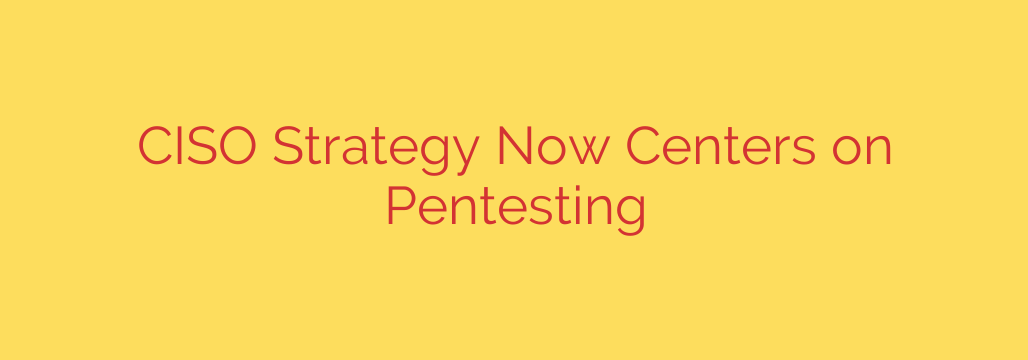
Beyond Compliance: Why Penetration Testing is the New Core of CISO Strategy
In today’s complex digital landscape, the role of the Chief Information Security Officer (CISO) has evolved dramatically. The days of security leadership being a checkbox-driven, compliance-focused role are over. Modern CISOs understand that simply meeting regulatory requirements is no longer a sufficient defense against sophisticated cyber threats. Instead, a new, more proactive philosophy is taking center stage: one that is built around the strategic use of penetration testing.
This shift marks a critical change from a defensive posture to an offensive one. Rather than waiting for an attack to happen, organizations are now actively simulating them to find and fix weaknesses before malicious actors can exploit them. This approach provides the real-world validation that compliance reports and vulnerability scans simply cannot offer.
The Limits of a Compliance-First Mindset
For years, many security programs were designed primarily to satisfy auditors and achieve compliance with frameworks like PCI DSS, HIPAA, or ISO 27001. While these standards provide a valuable baseline, they have significant limitations:
- A Snapshot in Time: Compliance audits often happen annually, offering only a momentary glimpse of an organization’s security posture. The threat landscape, however, changes daily.
- Theoretical vs. Practical Risk: A standard vulnerability scan might identify thousands of potential issues, but it can’t tell you which ones are actually exploitable in your specific environment.
- Reactive Nature: Compliance ensures you have certain controls in place, but it doesn’t test if those controls will hold up under the pressure of a targeted attack.
Relying solely on compliance is like having a blueprint for a fortress but never testing its walls against a battering ram. A successful audit does not equal a secure organization.
The Rise of Offensive Security: Thinking Like an Attacker
Penetration testing, or “pentesting,” flips the traditional security model on its head. It involves hiring ethical hackers to probe your networks, applications, and systems for exploitable vulnerabilities, mimicking the techniques a real-world attacker would use.
This offensive approach provides the context that raw data from scanners lacks. It answers the crucial questions that keep executives and board members up at night: “Are we truly secure? And how do we know?”
The strategic value of centering a security program on pentesting is driven by several key factors:
- Actionable, Risk-Based Prioritization: A pentest report doesn’t just list theoretical weaknesses; it demonstrates how they can be chained together to achieve a breach. This allows security teams to focus their limited resources on fixing the vulnerabilities that pose the greatest tangible risk to the business, rather than chasing down every low-impact finding.
- Demonstrating Tangible Security ROI: CISOs are under increasing pressure to justify massive security budgets. A successful pentest that uncovers a critical flaw is a powerful way to demonstrate the value of security investments. By showing how a multi-million dollar breach was prevented, CISOs can prove that tools, processes, and personnel are delivering real, protective value.
- Validating Security Controls Under Pressure: You may have a state-of-the-art firewall and an expensive EDR (Endpoint Detection and Response) solution, but will they perform as expected during a real attack? Pentesting provides a live-fire drill to validate that your security stack is configured correctly and that your defensive measures work in concert to detect and block threats.
- Training and Sharpening Defense Teams: When a pentest is underway, it serves as an invaluable, real-time training exercise for the internal security operations center (SOC) and incident response teams (the “blue team”). Seeing how an attacker moves through the network helps them hone their detection and response capabilities in a controlled environment, making them far more effective when a real incident occurs.
Actionable Security: How to Build a Pentesting-Informed Program
Transitioning to a pentesting-centric strategy requires more than just scheduling an annual test. It demands a new way of thinking about security validation.
Define Clear Objectives: Before any engagement, determine what you want to achieve. Are you testing a new application before it goes live? Simulating a ransomware attack? Or assessing your ability to detect a stealthy intruder? Clear goals ensure the pentest delivers relevant and actionable intelligence.
Go Beyond the Annual Checkbox: While annual tests for compliance are still necessary, a mature security program incorporates testing more frequently. Consider adopting a continuous model, often called Pentesting as a Service (PtaaS), which provides ongoing testing and faster feedback as your environment changes.
Integrate, Don’t Isolate: The results of a pentest should not live in a static PDF report. Findings must be integrated directly into developer and IT workflows (e.g., as tickets in Jira or Azure DevOps). This ensures vulnerabilities are tracked, assigned, and remediated efficiently.
Embrace the “Purple Team” Mindset: Foster collaboration between the offensive pentesters (red team) and your internal defenders (blue team). This collaborative approach, known as purple teaming, focuses on improving detection and response capabilities in real time, maximizing the value of each test.
Ultimately, the strategic shift towards penetration testing marks a significant maturation of the cybersecurity field. It represents a move from passive defense to proactive validation—from hoping you are secure to proving it. For the modern CISO, it’s no longer an optional exercise but the foundational pillar of a resilient and effective security strategy.
Source: https://www.helpnetsecurity.com/2025/08/11/pentesting-for-cisos/








